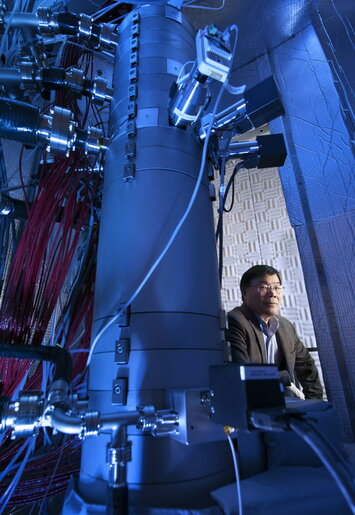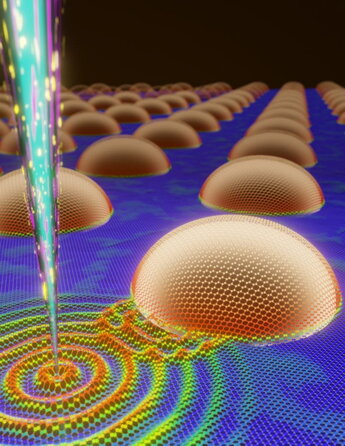UCI scientists observe effects of heat in materials with atomic resolution
13.06.2022Irvine, Calif., June 8, 2022 – As electronic, thermoelectric and computer technologies have been miniaturized to nanometer scale, engineers have faced a challenge studying fundamental properties of the materials involved; in many cases, targets are too small to be observed with optical instruments.

Using cutting-edge electron microscopes and novel techniques, a team of researchers at the University of California, Irvine, the Massachusetts Institute of Technology and other institutions has found a way to map phonons – vibrations in crystal lattices – in atomic resolution, enabling deeper understanding of the way heat travels through quantum dots, engineered nanostructures in electronic components.
To investigate how phonons are scattered by flaws and interfaces in crystals, the researchers probed the dynamic behavior of phonons near a single quantum dot of silicon-germanium using vibrational electron energy loss spectroscopy in a transmission electron microscope, equipment housed in the Irvine Materials Research Institute on the UCI campus. The results of the project are the subject of a paper published today in Nature.
“We developed a novel technique to differentially map phonon momenta with atomic resolution, which enables us to observe nonequilibrium phonons that only exist near the interface,” said co-author Xiaoqing Pan, UCI professor of materials science and engineering and physics, Henry Samueli Endowed Chair in Engineering, and IMRI director. “This work marks a major advance in the field because it’s the first time we have been able to provide direct evidence that the interplay between diffusive and specular reflection largely depends on the detailed atomistic structure.”

According to Pan, at the atomic scale, heat is transported in solid materials as a wave of atoms displaced from their equilibrium position as heat moves away from the thermal source. In crystals, which possess an ordered atomic structure, these waves are called phonons: wave packets of atomic displacements that carry thermal energy equal to their frequency of vibration.
Using an alloy of silicon and germanium, the team was able to study how phonons behave in the disordered environment of the quantum dot, in the interface between the quantum dot and the surrounding silicon, and around the dome-shaped surface of the quantum dot nanostructure itself.
“We found that the SiGe alloy presented a compositionally disordered structure that impeded the efficient propagation of phonons,” said Pan. “Because silicon atoms are closer together than germanium atoms in their respective pure structures, the alloy stretches the silicon atoms a bit. Due to this strain, the UCI team discovered that phonons were being softened in the quantum dot due to the strain and alloying effect engineered within the nanostructure.”
Pan added that softened phonons have less energy, which means that each phonon carries less heat, reducing thermal conductivity as a result. The softening of vibrations is behind one of the many mechanisms of how thermoelectric devices impede the flow of heat.
One of the key outcomes of the project was the development of a new technique for mapping the direction of the thermal carriers in the material. “This is analogous to counting how many phonons are going up or down and taking the difference, indicating their dominant direction of propagation,” he said. “This technique allowed us to map the reflection of phonons from interfaces.”
Electronics engineers have succeeded in miniaturizing structures and components in electronics to such a degree that they are now down to the order of a billionth of a meter, much smaller than the wavelength of visible light, so these structures are invisible to optical techniques.
“Progress in nanoengineering has outpaced advancements in electron microscopy and spectroscopy, but with this research, we are beginning the process of catching up,” said co-author Chaitanya Gadre, a graduate student in Pan’s group at UCI.
A likely field to benefit from this research is thermoelectrics – material systems that convert heat to electricity. “Developers of thermoelectrics technologies endeavor to design materials that either impede thermal transport or promote the flow of charges, and atom-level knowledge of how heat is transmitted through solids embedded as they often are with faults, defects and imperfections, will aid in this quest,” said co-author Ruqian Wu, UCI professor of physics & astronomy.
“More than 70 percent of the energy produced by human activities is heat, so it is imperative that we find a way to recycle this back into a useable form, preferably electricity to power humanity’s increasing energy demands,” Pan said.
Also involved in this research project, which was funded by the U.S. Department of Energy Office of Basic Energy Sciences and the National Science Foundation, were Gang Chen, MIT professor of mechanical engineering; Sheng-Wei Lee, professor of materials science and engineering at National Central University, Taiwan; and Xingxu Yan, a UCI postdoctoral scholar in materials science and engineering.
About UCI’s Brilliant Future campaign: Publicly launched on Oct. 4, 2019, the Brilliant Future campaign aims to raise awareness and support for UCI. By engaging 75,000 alumni and garnering $2 billion in philanthropic investment, UCI seeks to reach new heights of excellence in student success, health and wellness, research and more. The Henry Samueli School of Engineering and School of Physical Sciences play a vital role in the success of the campaign. Learn more by visiting https://brilliantfuture.uci.edu/the-henry-samueli-school-of-engineering/ and https://brilliantfuture.uci.edu/uci-school-of-physical-sciences/.
About the University of California, Irvine: Founded in 1965, UCI is the youngest member of the prestigious Association of American Universities and is ranked among the nation’s top 10 public universities by U.S. News & World Report. The campus has produced five Nobel laureates and is known for its academic achievement, premier research, innovation and anteater mascot. Led by Chancellor Howard Gillman, UCI has more than 36,000 students and offers 224 degree programs. It’s located in one of the world’s safest and most economically vibrant communities and is Orange County’s second-largest employer, contributing $7 billion annually to the local economy and $8 billion statewide. For more on UCI, visit www.uci.edu.